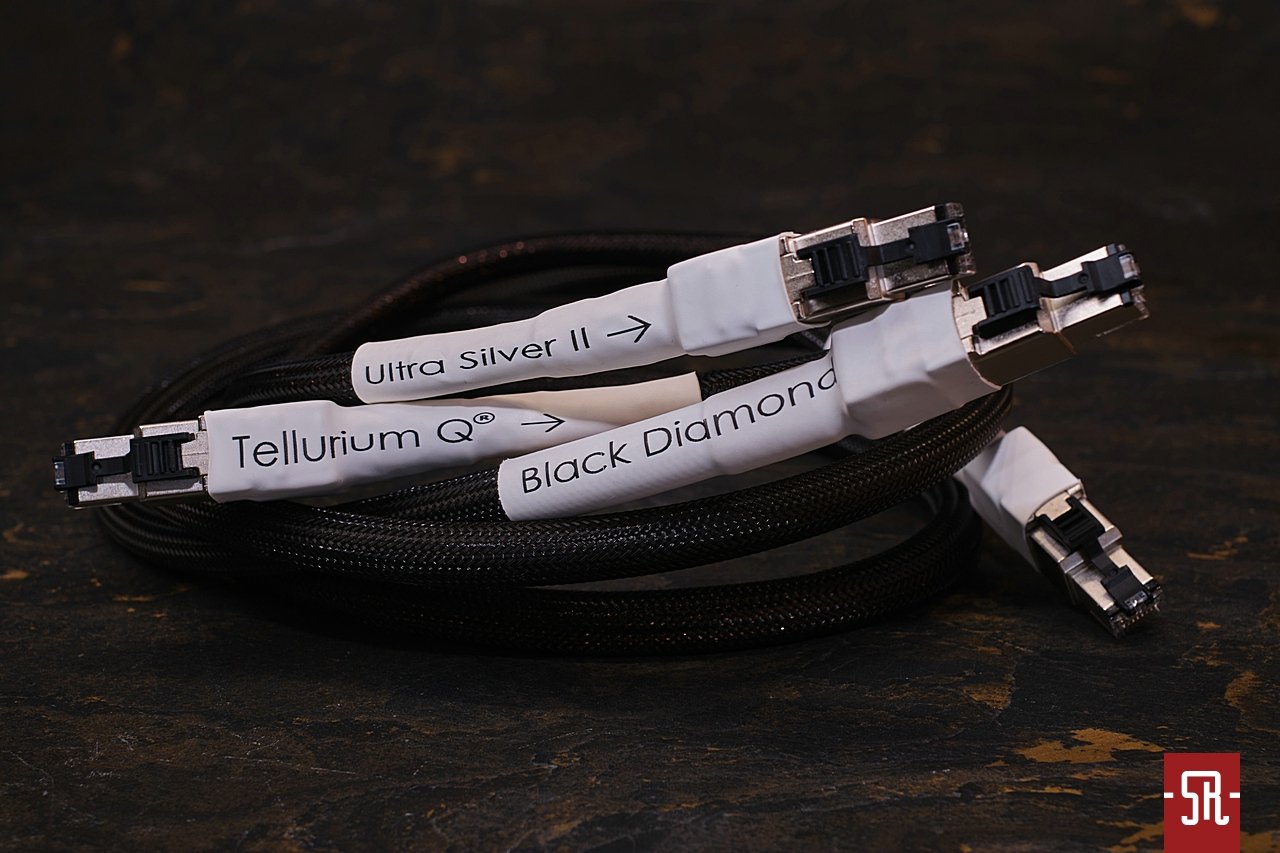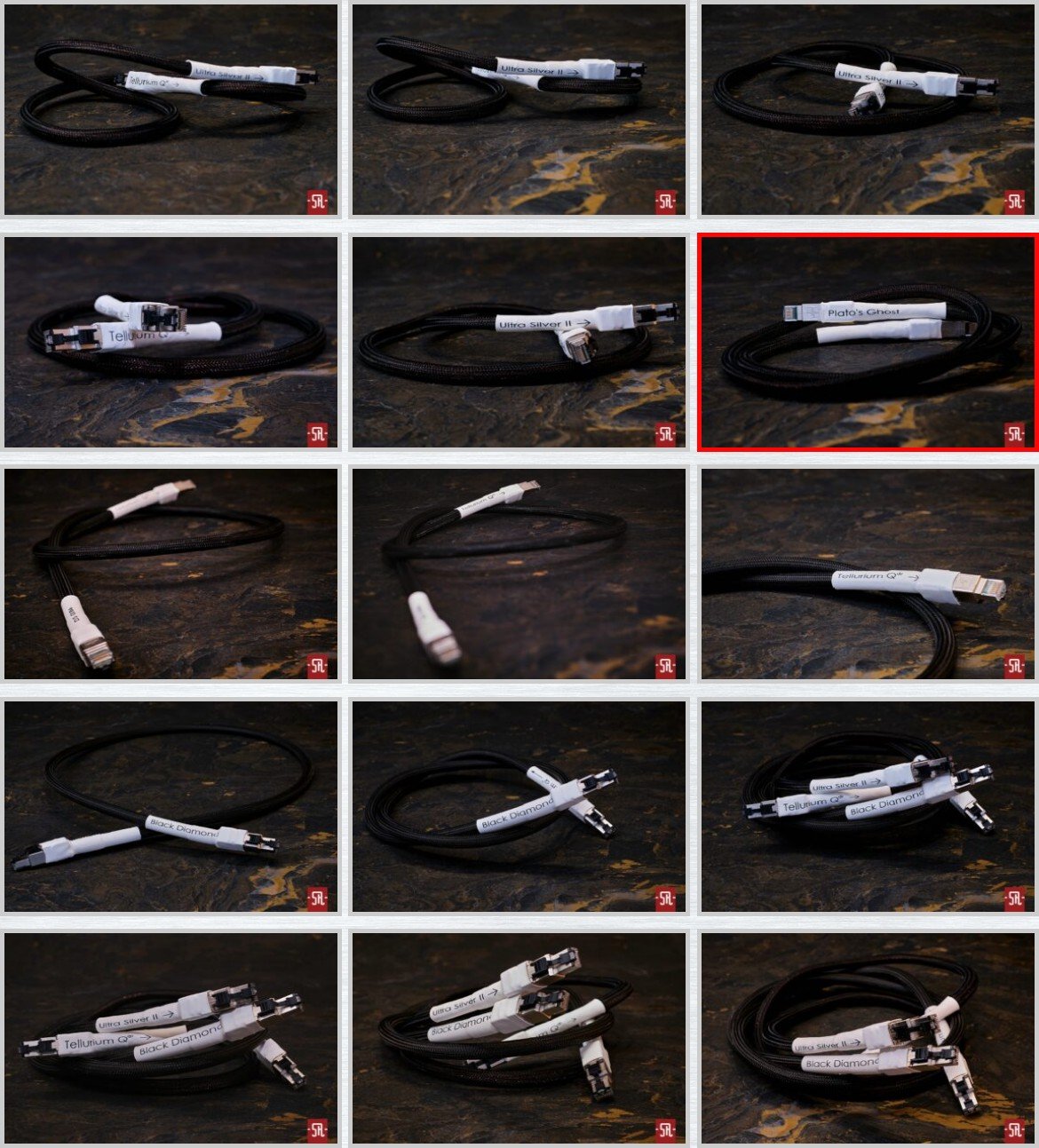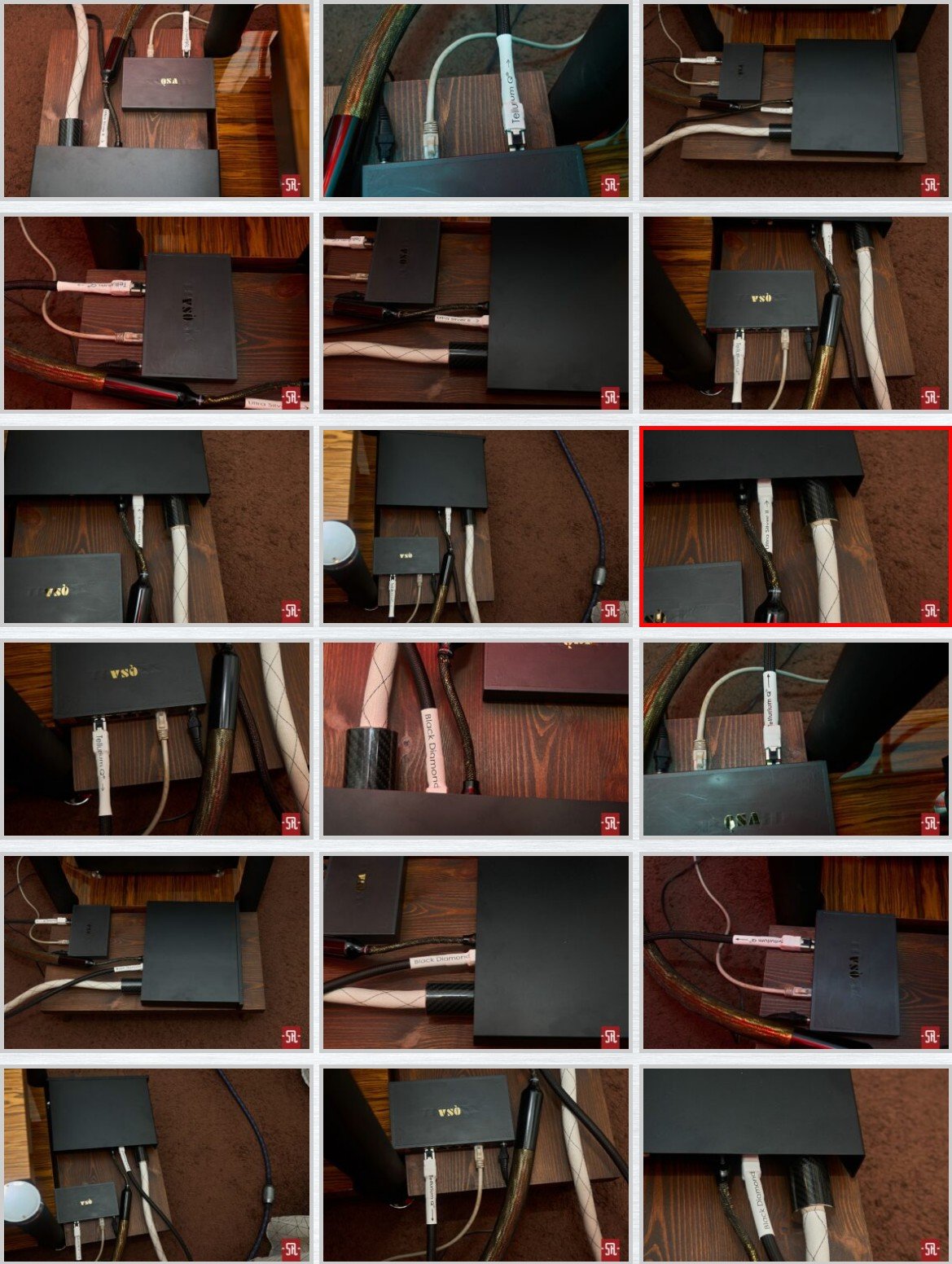- Home
- About us
- Blog
- Shop
- Brands
- ALL Brands List
- Analog Relax
- Antipodes Audio
- Audio Solutions
- AudioByte
- AudioCircle
- Audiomica Laboratory
- Canary Audio
- Canor Audio
- Chameleon Audio
- Dan D'agostino
- Eversolo
- Ferrum Audio
- Fezz Audio
- Glanz
- HiFiMAN
- HoloAudio
- LAB 12
- LAIV
- LampizatOr
- Magico
- Mega Acoustic
- Monrio Audio
- Origin Live
- Phasemation
- Pink Faun
- PLiXIR
- Qualiton
- Reed
- Remton
- Revival Audio
- Riviera Audio
- Rockna Audio
- Sbooster
- Shelter
- Sigma Acoustics
- Signal Projects
- SOtM Audio
- SPEC
- Takatsuki
- Takumi
- Tedeska
- Tellurium Q
- Trafomatic Audio
- Tsakiridis Devices
- Volumio
- Sales
- Second Hand Deals
- Account

Tellurium Q Ultra Silver II & Black Diamond Streaming Cable – Review by SoundRebels (English Translation)
Opinion 1
Although we’ve been dabbling in audio topics with varying degrees of intensity for over a quarter of a century, and can honestly say that fewer and fewer situations within this niche of human activity manage to surprise us, every time we take on the editorial task of describing cabling, somewhere subconsciously, in the back of our minds, we picture a scene from Gladiator with the iconic shout: “Unleash Hell!” It’s hard to deny that nothing quite raises the temperature of discussion—or even sparks spontaneous combustion—like cables, which, at least according to those who deny their functionality, “don’t play.”
Yet instead of accepting the existence of groups with differing opinions and simply going their own way, some—at least “along the Vistula”—feel compelled not only to proclaim their inability to hear Urbi et Orbi, but for reasons difficult to comprehend, to impose this deafness on those who do hear, while simultaneously denying them that very ability. It’s a bit like saying: since I couldn’t detect any special notes or aromas in a 50 PLN bottle of wine, then connoisseurs enjoying bottles costing ten or even a hundred times that amount surely don’t taste anything either, and are merely inflating the balloon of snobbery.
Well, such a view of the world—filtered through the lens of one’s own limitations—cannot be denied to anyone, as everyone lives as they wish, so long as they don’t try to force others into their own shoes. That’s why this time, fully aware of the extraordinary “flammability” of the issues at hand, we’ve decided, with truly stoic calm, to conduct the most objective analysis possible of two neighboring Ethernet cables from the British Tellurium Q catalog: the Ultra Silver II and the Black Diamond Streaming Cable, which we warmly invite you to test.

As you’ve surely noticed, cable manufacturers tend to fall into two camps: those who confess every last strand in the braid, and those who, at most, indicate… directionality. Among those who play with open cards, I’d include the Japanese brand Furutech, which documents each new product anatomically with almost pharmaceutical precision. So, when testing anything from their portfolio, we can safely assume that the technical content for the construction section is essentially taken care of.
On the other side stands, among others, the subject of today’s review—Tellurium Q. Geoff Merrigan, the man behind the brand, disarmingly states: “If you don’t believe our cables can make a difference, don’t listen to them. And if you’ve tried and don’t hear a difference—don’t buy.” It’s hard to argue with that logic, though it does put audio storytellers (ourselves included) in a tricky spot. After all, you can’t draw water from a stone, and here, any point of reference is hard to come by. Still, despite my self-preservation instinct, I reached out to Geoff about possibly lifting the veil on some company secrets—and managed to extract a few insights.
What does this have to do with ancient times and the philosophers who taught then? Quite a bit, actually. A keen eye will spot “Plato’s Ghost” on the Ultra Silver II’s sleeve—a nod to the eternal pursuit of perfection. Though unattainable, it inspires practical solutions that, through surprisingly varied paths, bring us closer to it.
So, in brief and without watering down the “concentrate”: the Black Diamond’s construction roughly resembles a classic Ethernet cable, while the Ultra Silver II is a kind of “mutated exhumant” (a high-end zombie?)—a project born from Geoff’s collaboration with his son Ben. While exploring old, discontinued projects—abandoned due to lack of resources or knowledge at the time—Ben stumbled upon an idea that, with some revised assumptions, had the potential to fulfill its original promise. Thus began a painstaking series of experiments based on signal propagation and conductor interaction, including shielding individual strands. Without spoiling the results, this led to some fascinating outcomes that placed the final product within the Ultra Silver series.
As for the appearance of the titular duo, we rely purely on organoleptic impressions—what’s known as the “macant test.” Both cables are dressed in synthetic, braided black sleeves and fitted with high-quality Telegärtner plugs, secured with white heat-shrink tubing bearing model names and the manufacturer’s logo. Aside from their identical 1-meter length, the similarities end there. The Ultra Silver II is uniformly black and as flexible as a shoelace, while the Black Diamond reveals a burgundy hue through its outer braid. Its diameter is noticeably larger, as are its stiffness and elasticity, making shorter-than-1-meter applications potentially problematic.
Moving on to sound, I’ll just note that I left both cables plugged into my home network for a week without knowing their prior usage. I set up playlists to ensure uninterrupted musical data flow and gave them time to settle. After this acclimation period, I rolled up my sleeves and began swapping them between the QSA Red switch, the Farad-powered Lumïn U2 Mini transport, and the networked Danish integrated Vitus Audio RI-101 MkII DAC/Streamer (review coming soon), observing a series of fraternal duels.
It turned out to be quite a thrilling exercise, as it involved detecting the sonic consequences of their anatomical differences. Since both used identical plugs, any signature from the connectors could be ruled out. Still, each cable—if not “played”—transmitted the stream of musical data in its own distinct way.
The Ultra Silver II, compared to my standby Next Level Tech NxLT Lan Flame, delivered a livelier and crisper sound. It could strike sharply on cymbals, yet built a phenomenal sense of depth, precisely layering the soundstage. Listening to For Those That Wish To Exist At Abbey Road by Architects and Communion by Septicflesh felt like racing an F1 car around Silverstone. The speed of the guitar riffs was breathtaking, transitions between rows of musicians happened in a blink, and each orchestral tutti—backed by a wall of metal cacophony—felt like the moment DRS finally kicks in. Pure adrenaline-fueled rock’n’roll madness.
In contrast, the Black Diamond resembled a 4-liter Aston Martin Vantage acting as a safety car—playing with greater volume and a darker, juicier tone, thanks to not needing to rev like a 1.6-liter F1 engine. It carried a native (Wagnerian?) grandeur and more energy in the lower range—the bass wasn’t just heard, as with the Silver, but felt.
Comparing the two 1:1, the Silver is more selective, leaning—if not a full step, then half—toward analytical precision. The Black Diamond operates in a denser, more organic aesthetic, bordering on analog resolution. Not the kind offered by most turntables (except those by TechDAS), but rather the good old reel-to-reel decks, which make those turntables sound surprisingly cautious and lifeless.
It’s worth noting that the Black Diamond isn’t as thick and sticky as our domestic David Laboga Custom Audio Ruby Ethernet, and it builds its soundstage slightly closer than its red-clad competitor. It also doesn’t try to dazzle or overwhelm the listener with its awesomeness like the spectacular Synergistic Research Galileo SX Ethernet. Instead, it operates with a far more balanced emotionality. Musically, I’d liken it more to the natural, effortless style of Carlos Santana or Eric Clapton than the technical prowess of Steve Vai or Joe Satriani.
As I quietly hope this text conveys, both British cables have clearly defined sonic signatures, making it easy for potential buyers to know—after just a few bars of their favorite music—which one will stay with them longer. While the Tellurium Q Ultra Silver II emphasizes drive, resolution, and airiness, the Black Diamond captivates with maturity and effortless presentation.
System used during the test
CD/DAC: Vitus Audio SCD-025 Mk.II + 2 x Quantum Science Audio (QSA) Blue fuse
File Player: Lumïn U2 Mini + Farad Super3 + Farad DC Level 2 copper cable + Omicron Magic Dream Classic; I-O Data Soundgenic HDL-RA4TB
Turntable: Denon DP-3000NE + Denon DL-103R
Phono Preamplifier: Tellurium Q Iridium MM/MC Phono Pre Amp
Digital Source Selector: Audio Authority 1177
Integrated Amplifier: Vitus Audio RI-101 MkII + Quantum Science Audio (QSA) Violet fuse
Speakers: AudioSolutions Figaro L2 + Solid Tech Feet of Balance + ZenSati Angel jumpers
RCA Interconnects: Furutech FA-13S; phono NEO d+ RCA Class B Stereo + Ground (1m)
XLR Interconnects: Vermöuth Audio Reference; Furutech DAS-4.1
Digital Interconnects: Fadel art DigiLitz; Harmonic Technology Cyberlink Copper; Apogee Wyde Eye; Monster Cable Interlink LightSpeed 200
USB Cables: Wireworld Starlight; Vermöuth Audio Reference USB; ZenSati Zorro
Speaker Cables: WK Audio TheRay Speakers + SHUBI Custom Acoustic Stands MMS-1
Power Cables: Esprit Audio Alpha; Furutech FP-3TS762 / FI-28R / FI-E38R; Organic Audio Power + Furutech CF-080 Damping Ring; Furutech Evolution II Power; Furutech Nanoflux Power NCF
Power Strip: Furutech e-TP60ER + Furutech FP-3TS762 / Fi-50 NCF(R) /FI-50M NCF(R)
Wall Outlet: Furutech FT-SWS-D (R) NCF
Switch: QSA Red + Silent Angel S28 feet + Farad Super6 power supply + Farad DC Level 2 copper cable
Ethernet Cables: In-akustik CAT6 Premium II; Audiomica Laboratory Anort Consequence, Artoc Ultra Reference, Arago Excellence; Furutech LAN-8 NCF; Next Level Tech NxLT Lan Flame
Anti-vibration Platform: Franc Audio Accessories Wood Block Slim Platform
Rack: Solid Tech Radius Duo 3
Acoustic Panels: Vicoustic Flat Panel VMT
Marcin Olszewski
Opinion 2
I am 100% convinced that in our pursuit of refining audio systems, we all have three types of acquaintances. The first group consists of staunch advocates of their own version of the truth when it comes to any influence that cabling might have on the sound of a setup. They are so orthodox that even if you showed them changes with the proverbial finger, they would often admit they hear something, but don’t understand it—and therefore refuse to acknowledge any actions in this area, even those they themselves audibly perceive.
The second group includes individuals who are aware that the topic is an important element of experiencing music in its highest-quality presentation, but who treat it carelessly. Even if they don’t use the so-called “computer cables” that come bundled with devices, they opt for cheap or random constructions of this type. The system sounds as it sounds, but the most important thing is that it plays.
The third group is us—those who fully understand this very important topic, having verified it many times “by ear.” We are the audio freaks who, sometimes in search of better sound quality from our existing setup, and sometimes simply to change its aesthetic presentation, test new market arrivals in our own equipment environment.
And it is precisely for this last group that we’ve taken under review two products from different lines—extremely controversial for a large group of music lovers in today’s discussion on belief and conscious use of various types of cabling: streaming cables. Specifically, we’re talking about digital cables, more precisely their LAN versions, whose visit to our premises was arranged by the Łódź-based distributor Szymański Audio.
What landed in our hands? Products from the well-known English brand Tellurium Q, familiar from our pages, in the form of LAN cabling from the Ultra Silver II Streaming Cable and Black Diamond Streaming Cable series.

What do we know about the construction of Tellurium Q products? Unfortunately, nothing. Really—because what can we deduce from the producer’s vague statement that the new models are more technically advanced with a few new solutions compared to their predecessors? You’ll agree, that’s not much. Is this open mockery of customers? By no means—it’s a matter of protecting their engineering legacy, which, in an era where everything is openly counterfeited by everyone—Chinese companies even counterfeit other Chinese products—clearly proves that laying proverbial cards on the table can result in a company’s disappearance from the market. And not even entirely due to the tricks of Asian manufacturers, but because of individuals who deliberately buy counterfeit products, as they’re the ones fueling this trend. I don’t know about you, but living off my own earnings—not a salary from a proverbial factory job—I understand this perfectly.
Starting the sound description based on what I heard, I can’t help but refer back to the introduction. Gentlemen defenders of the rights of deceived music lovers—even when comparing products from the same stable—there’s no way to defend your thesis that digital cabling doesn’t affect the final sound of an audio system. And these aren’t constructions from opposite ends of the price spectrum—cheapest vs. most expensive—as they differ by only three steps on the brand’s internal ladder. Yet, these two cables are worlds apart in terms of musical presentation aesthetics. Does that mean one of them is defective? Not at all—it’s simply the natural result of using slightly different components and internal construction in each, ultimately offering the potential buyer a product tailored to the needs of their current system.
So how did the cables in question perform? As I mentioned, they’re two different worlds.
The more affordable one—Ultra Silver II—focused on smoothness and plasticity in service of a calm presentation. What were the effects? The first thing that comes to mind is a general toning down of excessive fireworks during music playback. The presentation receives a dose of pleasant balm-like quality, which suppresses unwanted peaks such as overly sharp rendering of phantom image edges and painfully exaggerated treble. As a result, the music gains a higher level of fluidity, allowing us to spend long hours with it without fatigue. Importantly, it also avoids monotony, as the calmness still carries elements of nostalgia or madness, depending on the genre. True, it’s delivered with an aesthetic leaning more toward beauty than aggression—but that’s a deliberate design choice achieved through the cable’s unique construction. And it’s probably this last trait of the Ultra Silver II that surprised me most—in a positive way. At first, I thought it was a clear sedative, but after understanding its effect, it turned out that while you won’t get unpredictable fireworks, you can still enjoy tracks like AC/DC or Metallica with great expression. There’s a noticeable touch of well-applied refinement, but it doesn’t kill the rebellious spirit that lives in rock musicians.
Writing about the more expensive LAN cable in today’s piece—the Black Diamond—I’ll loyally warn all potential buyers, in the best sense of the word: it takes no prisoners. To clarify, let me immediately reassure you—it’s about its brilliantly executed vitality. Strong lines, solid bass punch, saturated mids, and radiant highs showed how to shake the listener with music without overwhelming them with excessive sharpness. For me, lively musical delivery is the core criterion of excellent system sound, but exaggerating individual elements makes it intrusive and tiring over time. In this case, I appreciated the unrestrained drive, yet it stayed within the bounds of good taste—so neither the sparkling cymbals nor the powerful jazz double bass passages suffered, nor did the wildly played but usually poorly produced rock. Compared to its predecessor, everything sounded more energetic, faster, and more vivid—but somehow only in service of injecting the right dose of adrenaline into the material, not delivering uncontrolled effects like those from unknown designer drugs. Adrenaline, first and foremost, for fans of heavy sound—almost essential even at the cost of reproducing poorly mastered material—but also often desired by music lovers who revel in sharp virtual stage rendering. This cable processes what it’s given with a fairly bold stroke, but not so much as to ruin the final sonic result. How it does that—I don’t know. What I do know is that it does it brilliantly.
How would I sum up the above description? Are both cables worth attention? And if so, why? I’ll be blunt. Regardless of their sonic offerings within their class and execution of specific sonic tasks, they’re very interesting constructions. Each is aimed at a different target group, because it’s obvious that every music lover has different problems to solve or different expectations for fulfilling their sonic preferences. Naturally, their price positioning within the brand’s catalog also plays a significant role, being the result of varying technical sophistication and the resulting presentation. Who would I recommend them to? That’s probably clear from the description above. If someone seeks calmness, the Tellurium Q Ultra Silver II should work excellently. On the other hand, if someone wants to collide with general musical madness in pursuit of their dreams, the Tellurium Q Black Diamond will help without issue. As I wrote—they’re two worlds, which means each of you has a very good chance of finding common ground with the constructions of this brand. A brand whose several products I’ve used over the years—and I know it’s worth the proverbial sin.
Jacek Pazio
System used in the test:
CD player: Gryphon Ethos
Streamer: Lumin U2 Mini + switch QSA Red-Silver
Preamplifier: Gryphon Audio Commander
Power amplifier: Gryphon Audio APEX Stereo
Speakers: Gauder Akustik Berlina RC-11 Black Edition
Speaker cables: Furutech Nanoflux-NCF Speaker Cable
RCA interconnects: Hijiri Million “Kiwami”, Vermouth Audio Reference
XLR interconnects: Hijiri Milion “Kiwami”, Furutech DAS-4.1, Furutech Project V1
Digital interconnect (XLR): Furutech Project V1 D XLR
LAN cable: NxLT LAN FLAME
USB cable: ZenSati Silenzio
Power cables: Hijiri Takumi Maestro, Furutech Project-V1, Furutech NanoFlux NCF, Furutech DPS-4.1 + FI-E50 NCF(R)/ FI-50(R), Hijiri Nagomi, Vermouth Audio Reference Power Cord, Acrolink 8N-PC8100 Performante, Synergistic Research Galileo SX AC, ZenSati Angel
Rack: BASE AUDIO 2.
Accessories:
Fuses: Quantum Science Audio Red, QSA Silver, Synergistic Research Orange
Anti-vibration platform: Solid Tech
Power conditioner: Harmonix AC Enacom Improved for 100-240V
Power strip: Power Base High End, Furutech NCF Power Vault-E
Acoustic panels: Artnovion
Analog system:
Turntable: Clearaudio Concept
Cartridge: Dynavector DV20X2H
Phono preamplifier: RCM Audio The Big Phono
Record clamp: DS Audio ES-001
Reel-to-reel tape recorder: Studer A80
